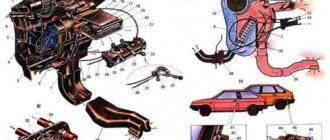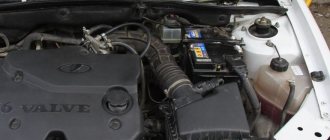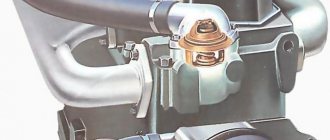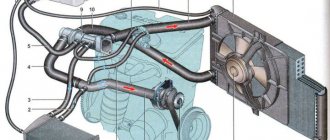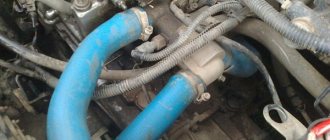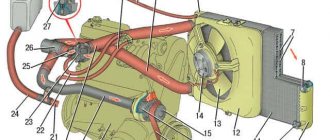The presence of air in the car's cooling system causes problems with engine overheating and ineffective operation of the interior heater. This article will present 4 methods by which it will become clear how to expel air from the cooling system of a VAZ 2114. The methods for solving the problem described in this article can be used on the entire family of first and second Samaras.
Useful video:
Signs of airing
The problem of air getting into the cooling system does not appear unnoticed. An increase in engine temperature, poor performance of the stove, and the presence of antifreeze leaks are clear signs of an airy system. Signs of an air lock in the VAZ 2114 cooling system:
- Engine overheating due to uneven cooling;
- Dips when pressing the gas pedal;
- No heating from the stove.
Violation of the temperature regime of the engine leads to its accelerated wear. Breaking the cylinder block gasket and getting antifreeze into the oil is not the worst scenario for such a malfunction. Engine wedge and the appearance of cracks in the cylinder block often occur precisely because of overheating, so you should carefully monitor the readings of the temperature sensor on the dashboard.
There are several reasons for problems with airing:
- A non-working thermostat jams, causing the temperature of the antifreeze to rise and it gradually evaporates;
- Leaking pipes;
- A breakdown in the cylinder block gasket leads to leakage of antifreeze into the cylinders (white steam from the exhaust pipe and the presence of an emulsion instead of oil is a sign of a broken gasket);
- Defective pressure relief cap on the expansion tank.
In any case, the problem with the air lock must be corrected promptly. Methods to expel air from the VAZ 2114 cooling system are described below.
Helpful : What to do if the heater blows cold air onto the windshield?
Cooling system features
To understand the essence of airing and the consequences that an airlock can lead to, you need to understand the cooling system itself. It is not recommended to start repairs with your own hands without having at least basic theoretical knowledge:
- VAZ-2114 cars are based on a closed liquid cooling system;
- antifreeze or antifreeze is used as a coolant;
- special channels serve to circulate coolant throughout the engine;
- circulation is carried out using a pump, which, in turn, is driven by the crankshaft through a drive belt;
- The thermostat is responsible for regulating the flow of coolant and its direction;
- the thermostat has a design that allows it to circulate in a small circle until the coolant warms up to the required parameters (in this case, the coolant does not enter the radiator);
- when the temperature reaches 87 degrees, an opening occurs and the coolant penetrates directly into the radiator;
- The radiator is blown by air flows when the car is moving;
- if natural airflow fails, then the electric fan is activated;
- a special sensor is responsible for turning it on;
- hot liquid penetrates through the heater radiator and allows the antifreeze to be warmed up in winter;
- excess antifreeze, which is formed during its thermal expansion, ends up in an additional (expansion) tank.
As you can see, if there is a plug in this chain, this can lead to serious negative consequences for the VAZ-2114.
Method 1
When starting to consider ways to remove an air lock from the cooling system of a VAZ 2114, the first step is to consider the easiest option. This method is based on physics. Because air in a liquid always tends to the top, you can put the front of the car on a hill, then unscrew the cap of the expansion tank and wait for the air to come out. Also, when lifting the car, you need to warm up the engine.
Adding gas will speed up the process of air leaving the system. Also, in the process of removing the plug, you need to switch the stove to the hottest mode and turn on the first fan speed. This method does not always help, because... it all depends on the location of the plug in the circuit. If there are leaks from the pipes or from under the thermostat, this method will only give a temporary effect, because the circuit will become leaky and will take in air again. Since it is not always possible to remove an air lock from the cooling system the first time, you can use other methods.
Methods for expelling air from the VAZ-2115 stove
If a motorist has diagnosed his car and realized that his VAZ-2115 heater is blown, he should use at least one of the methods below, which are considered quite effective solutions to the problem.
First method (blowing out the system)
According to the very first method, the motorist needs to dismantle the plastic casing covering the vehicle’s power unit. To remove this structural element, you will have to unscrew the cap covering the hole for adding oil. Then you need to remove the cover. It is worth noting that immediately after removing the protective casing, the cover should be returned to its place, which will preserve the cleanliness of the power unit by preventing the possibility of dirt and dust from entering.
The next step, which can solve the problem of airiness in the system, should be to search for the pipes responsible for warming up the throttle assembly. At this stage, it is necessary to pull off any pipe and, having twisted the lid from the hole in the container with antifreeze, cover the resulting “hole” with a clean rag.
To get rid of the malfunction, you will have to actively blow out the internal space of the tank. Through such actions, pressure is created, which pushes the collected air out. The need to stop the procedure should be indicated by the antifreeze coming from the pipe, since it will begin to come out only after there are no air accumulations left in the system.
After blowing out the VAZ-2115 system, the tube must be returned to its original place, and you should not hesitate, everything should be done as quickly as possible, otherwise a “portion” of unnecessary air will again appear in the tank.
Second method
If the VAZ-2115 stove is very airy, you can get rid of the resulting plug in just a few minutes without blowing out the system. To expel the accumulation of air, after actively warming up the power unit for 15 minutes, turn it off and, with the expansion tank cap closed, remove any pipe on the throttle assembly. After antifreeze or antifreeze starts coming out, you need to quickly insert the pipe into its original place. However, when using this method, one should not forget that after the power unit was running, the antifreeze could warm up to 80 °C.
Third method
The instructions described below will most likely help anyone whose VAZ-2115 stove is airy. To clean the system, you must first place the car at an angle; for this, a steep hill is suitable; the vehicle should stand with its nose at the highest point. After the car is put on the handbrake, and special stands are installed under all the wheels to protect the driver from unexpected rolling, you need to twist the plugs that close the holes on the radiator and expansion tank.
The power unit must be activated for at least 10 minutes so that it has time to warm up, then you need to press the accelerator pedal periodically, while adding coolant to the system.
Topping up antifreeze or antifreeze should be done until bubbles stop appearing. After they completely disappear, the work can be completed.
Method 2
A more sophisticated and effective way to get rid of a traffic jam is to create pressure in the system by the owner of the car himself. Briefly, the essence of the method is the following steps:
- Unscrew the engine oil filler cap;
- Remove the rubber gasket from it and return the cover to its place;
- Next, unscrew the cap from the expansion tank;
- Release one of the tubes leading to the throttle from the clamp and remove it from the metal pipe;
- Cover the neck of the tank with your mouth and blow into it, creating pressure in the circuit;
- After the antifreeze begins to flow out of the pipe without bubbles, put it in place and tighten it with a clamp;
- Reassemble the removed parts in reverse order.
This method may seem unsafe, because... There is a risk of inhaling antifreeze vapors when blowing air, but at low temperatures this procedure is safe. If the cooling system is still not free of the plug, use the following method.
General recommendations for prevention
The first thing you need to pay attention to is the level of antifreeze in the cooling system . Always monitor it and top up if necessary. Moreover, if you have to add coolant very often, then this is the first call indicating that something is wrong with the system, and additional diagnostics are necessary to identify the cause of the malfunction. Also check for stains from antifreeze leaks. It is better to do this in the inspection hole.
Remember to periodically clean the cooling system. You can read how and by what means to do this in the relevant articles on our website.
Try to use the antifreeze recommended by your car manufacturer. Make purchases in trusted, licensed stores, minimizing the likelihood of purchasing a counterfeit. The fact is that low-quality coolant can gradually evaporate during repeated heating, and instead of it, an air plug forms in the system. Therefore, do not neglect the manufacturer's requirements.
Instead of a conclusion
Finally, I would like to note that if the described signs of airing in the system appear, it is necessary to carry out diagnostics and check it as quickly as possible. After all, an air lock significantly reduces the efficiency of the cooling system. Because of this, the engine operates under conditions of increased wear, which can lead to premature failure. Therefore, if you detect airing, try to get rid of the plug as quickly as possible. Fortunately, even a novice car enthusiast can do this, since the procedure is simple and does not require the use of additional tools or devices.
Method 3
The troubleshooting algorithm looks like this:
- Warm up the engine to operating temperature without allowing the cooling fan to operate;
- Similar to the second method, remove one of the pipes from the throttle;
- When you remove one of the tubes, air will come out, after which antifreeze will begin to flow out. At the same moment, place the tube in place and tighten the clamp.
Understanding how to remove air from the cooling system on a VAZ 2114 allows you to eliminate the problem of sudden engine overheating due to a traffic jam anywhere. It is enough to have a screwdriver to unscrew the pipes from the throttle and work on eliminating air can begin.
Method 4
The most effective, but labor-intensive method to fix the problem is described below. The only thing additionally required is a container of antifreeze.
- First, warm up the engine to operating temperature;
- Raise the front of the car so that the radiator cap is the highest point;
- Remove one of the pipes from the throttle and dip it in a container with antifreeze;
- Then, simultaneously with adding gas, add antifreeze to the tank;
- As soon as the bubbles in the container disappear, you can put the pipe back in place.
You need to understand that an air lock in the cooling system over time can cause sudden overheating of the engine and complete failure of the stove. You can ventilate the circuit yourself using the methods described above, but you should regularly check all connections and the tank for leaks. If even after removing the plug the engine continues to heat up, check the condition of the thermostat. Also, to prevent leaks, change the clamps on the pipes. Their rare use leads to relaxation of the pipes to the radiator, expansion tank and thermostat. For reliability, you can use joint sealant on the last element.
Causes of air locks
Air is characterized by relatively low thermal conductivity, and by itself it is rarely used as a cooling agent (the exception is radiator blowing, but the reasons here are prosaic - the complete absence of energy costs). But its danger when mixed with technical fluids lies not so much in the reduction of heat capacity, but in the formation of air pockets, which, accumulating at the highest points of the line, prevent the free flow of coolant.
When does air leak into a sealed engine cooling system? There may be several reasons:
- depressurization of the system is a violation of the integrity of the connections of pipes, tubes, hoses at the point of their attachment to the fittings, which leads to such a phenomenon as suction of outside air. This can happen as a result of overheating, accidental mechanical impact, inept driver actions, or due to natural wear and tear. Separately, it is worth mentioning cases where loss of tightness occurs due to prolonged exposure to low pressure in the system, observed at the surface of the pipeline walls during coolant movement;
- Many drivers don’t even realize that when replacing or adding antifreeze, if done quickly, a large funnel is formed that does not allow air to escape. As a result, a noticeable amount of air enters the system, which threatens the formation of traffic jams with all the ensuing consequences. Therefore, the recommendation to pour antifreeze in a thin stream, regardless of time, remains relevant for a significant part of car owners;
- problems with the functioning of the air valve. A pump is used to circulate coolant in the system, but the pressure created is not static: due to the heating of the liquid, the pressure increases in certain sections of the line, and decreases in the area of the radiator. This is, in principle, normal. But in some cases, the area of high pressure reaches the expansion tank, the air in which is compressed, and the valve in the tank lid bleeds it out. At reduced pressure, the reverse process occurs - air is sucked in. But if the valve is stuck, then it only works in one direction. This is fraught with the accumulation of air mass, which is simply forced to move on through the pipelines, mixing with the coolant;
- air can penetrate into the CO through a leaky pump seal, as well as through the fiber if it has end-to-end mechanical defects;
- antifreeze leaks through the connections of hoses, pipes and both radiators may not lead to air entering the system through them, but in such cases the volume of coolant decreases, which automatically leads to an increase in air volume (through the expansion tank). If the radiator is clogged, the engine begins to overheat, and collectively this leads to the formation of traffic jams;
- Violation of the integrity of the cylinder head gasket is another common cause of antifreeze leakage penetrating into the cylinders, as a result of which the volume of coolant decreases, and you already know the consequences of this phenomenon.


